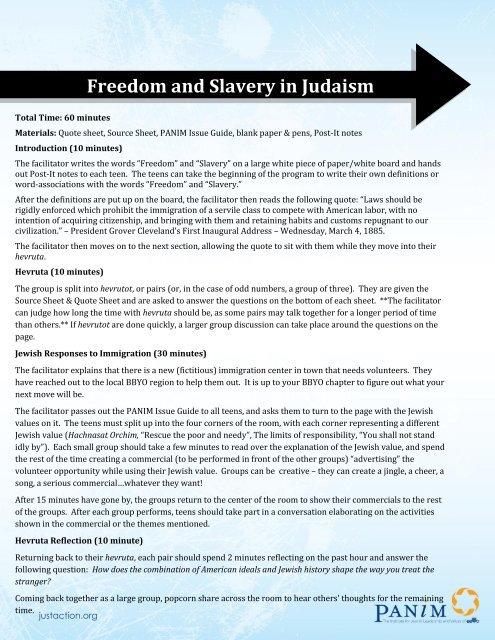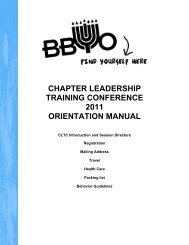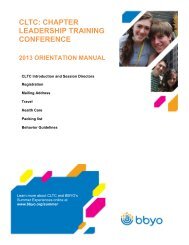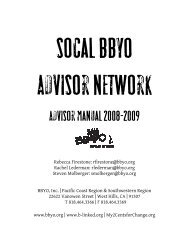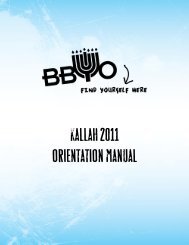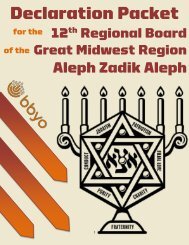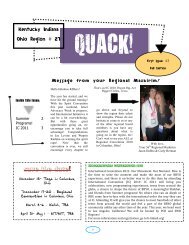Freedom and Slavery in Judaism - Panim - BBYO
Freedom and Slavery in Judaism - Panim - BBYO
Freedom and Slavery in Judaism - Panim - BBYO
Create successful ePaper yourself
Turn your PDF publications into a flip-book with our unique Google optimized e-Paper software.
Total Time: 60 m<strong>in</strong>utes<br />
<strong>Freedom</strong> <strong>and</strong> <strong>Slavery</strong> <strong>in</strong> <strong>Judaism</strong><br />
Materials: Quote sheet, Source Sheet, PANIM Issue Guide, blank paper & pens, Post-It notes<br />
Introduction (10 m<strong>in</strong>utes)<br />
The facilitator writes the words “<strong>Freedom</strong>” <strong>and</strong> “<strong>Slavery</strong>” on a large white piece of paper/white board <strong>and</strong> h<strong>and</strong>s<br />
out Post-It notes to each teen. The teens can take the beg<strong>in</strong>n<strong>in</strong>g of the program to write their own def<strong>in</strong>itions or<br />
word-associations with the words “<strong>Freedom</strong>” <strong>and</strong> “<strong>Slavery</strong>.”<br />
After the def<strong>in</strong>itions are put up on the board, the facilitator then reads the follow<strong>in</strong>g quote: “Laws should be<br />
rigidly enforced which prohibit the immigration of a servile class to compete with American labor, with no<br />
<strong>in</strong>tention of acquir<strong>in</strong>g citizenship, <strong>and</strong> br<strong>in</strong>g<strong>in</strong>g with them <strong>and</strong> reta<strong>in</strong><strong>in</strong>g habits <strong>and</strong> customs repugnant to our<br />
civilization.” – President Grover Clevel<strong>and</strong>’s First Inaugural Address – Wednesday, March 4, 1885.<br />
The facilitator then moves on to the next section, allow<strong>in</strong>g the quote to sit with them while they move <strong>in</strong>to their<br />
hevruta.<br />
Hevruta (10 m<strong>in</strong>utes)<br />
The group is split <strong>in</strong>to hevrutot, or pairs (or, <strong>in</strong> the case of odd numbers, a group of three). They are given the<br />
Source Sheet & Quote Sheet <strong>and</strong> are asked to answer the questions on the bottom of each sheet. **The facilitator<br />
can judge how long the time with hevruta should be, as some pairs may talk together for a longer period of time<br />
than others.** If hevrutot are done quickly, a larger group discussion can take place around the questions on the<br />
page.<br />
Jewish Responses to Immigration (30 m<strong>in</strong>utes)<br />
The facilitator expla<strong>in</strong>s that there is a new (fictitious) immigration center <strong>in</strong> town that needs volunteers. They<br />
have reached out to the local <strong>BBYO</strong> region to help them out. It is up to your <strong>BBYO</strong> chapter to figure out what your<br />
next move will be.<br />
The facilitator passes out the PANIM Issue Guide to all teens, <strong>and</strong> asks them to turn to the page with the Jewish<br />
values on it. The teens must split up <strong>in</strong>to the four corners of the room, with each corner represent<strong>in</strong>g a different<br />
Jewish value (Hachnasat Orchim, “Rescue the poor <strong>and</strong> needy”, The limits of responsibility, “You shall not st<strong>and</strong><br />
idly by”). Each small group should take a few m<strong>in</strong>utes to read over the explanation of the Jewish value, <strong>and</strong> spend<br />
the rest of the time creat<strong>in</strong>g a commercial (to be performed <strong>in</strong> front of the other groups) “advertis<strong>in</strong>g” the<br />
volunteer opportunity while us<strong>in</strong>g their Jewish value. Groups can be creative – they can create a j<strong>in</strong>gle, a cheer, a<br />
song, a serious commercial…whatever they want!<br />
After 15 m<strong>in</strong>utes have gone by, the groups return to the center of the room to show their commercials to the rest<br />
of the groups. After each group performs, teens should take part <strong>in</strong> a conversation elaborat<strong>in</strong>g on the activities<br />
shown <strong>in</strong> the commercial or the themes mentioned.<br />
Hevruta Reflection (10 m<strong>in</strong>ute)<br />
Return<strong>in</strong>g back to their hevruta, each pair should spend 2 m<strong>in</strong>utes reflect<strong>in</strong>g on the past hour <strong>and</strong> answer the<br />
follow<strong>in</strong>g question: How does the comb<strong>in</strong>ation of American ideals <strong>and</strong> Jewish history shape the way you treat the<br />
stranger?<br />
Com<strong>in</strong>g back together as a large group, popcorn share across the room to hear others’ thoughts for the rema<strong>in</strong><strong>in</strong>g<br />
time. justaction.org
justaction.org<br />
Hevruta Source Sheet<br />
<strong>Freedom</strong> <strong>and</strong> <strong>Slavery</strong> <strong>in</strong> <strong>Judaism</strong><br />
Dur<strong>in</strong>g the annual Passover seder, the Jewish people refer to the times when ancient Israelites were<br />
slaves <strong>in</strong> Egypt. With<strong>in</strong> the Passover Haggadah, we re-tell the experience with<strong>in</strong> <strong>and</strong> escap<strong>in</strong>g from<br />
slavery <strong>in</strong> Egypt. Through our underst<strong>and</strong><strong>in</strong>g of our ancestors’ time enslaved <strong>in</strong> Egypt, the Jewish people<br />
have a unique recognition <strong>and</strong> relationship to stranger. The Israelites are rem<strong>in</strong>ded throughout the<br />
Torah, after the Exodus, that they, too, were once strangers. In Exodus 22, God comm<strong>and</strong>s the Israelites,<br />
say<strong>in</strong>g “You shall not wrong a stranger, nor oppress him; for you were strangers <strong>in</strong> the l<strong>and</strong> of Egypt.”<br />
The constant rem<strong>in</strong>ders of the Israelites’ past br<strong>in</strong>gs with it the <strong>in</strong>structions to treat others well. The<br />
relationship between “freedom” <strong>and</strong> “the stranger,” therefore, is connected.<br />
Read through all three texts <strong>and</strong> answer the questions at the bottom of the page.<br />
“Also, you shall not oppress a stranger; for you know the heart of a stranger,<br />
see<strong>in</strong>g you were strangers <strong>in</strong> the l<strong>and</strong> of Egypt.” - Exodus 23:9<br />
“And if a stranger sojourns with you <strong>in</strong> your l<strong>and</strong>, you shall not wrong him.<br />
But the stranger who dwells with you shall be to you as one born among you,<br />
<strong>and</strong> you shall love him as yourself; for you were strangers <strong>in</strong> the l<strong>and</strong> of<br />
Egypt; I am your God.” - Leviticus 19:33-34<br />
“Five score years ago, a great American, <strong>in</strong> whose symbolic shadow we st<strong>and</strong><br />
signed the Emancipation Proclamation. This momentous decree came as a<br />
great beacon light of hope to millions of Negro slaves who had been seared <strong>in</strong><br />
the flames of wither<strong>in</strong>g <strong>in</strong>justice. It came as a joyous daybreak to end the long<br />
night of captivity. But one hundred years later, we must face the tragic fact<br />
that the Negro is still not free. One hundred years later, the life of the Negro is<br />
still sadly crippled by the manacles of segregation <strong>and</strong> the cha<strong>in</strong>s of<br />
discrim<strong>in</strong>ation. One hundred years later, the Negro lives on a lonely isl<strong>and</strong> of<br />
poverty <strong>in</strong> the midst of a vast ocean of material prosperity. One hundred years<br />
later, the Negro is still languish<strong>in</strong>g <strong>in</strong> the corners of American society <strong>and</strong><br />
f<strong>in</strong>ds himself an exile <strong>in</strong> his own l<strong>and</strong>.”<br />
Dr. Mart<strong>in</strong> Luther K<strong>in</strong>g, Jr., 1963<br />
1. What is it about the experience <strong>in</strong> Egypt that is <strong>in</strong>voked when we’re told to treat the stranger well?<br />
2. How does Dr. K<strong>in</strong>g’s speech channel the themes from the Torah?<br />
3. What does Dr. K<strong>in</strong>g th<strong>in</strong>k about freedom <strong>in</strong> America? What do you th<strong>in</strong>k about freedom <strong>in</strong><br />
America?<br />
4. How have you witnessed freedom or the idea of the stranger? Would your experiences be <strong>in</strong> l<strong>in</strong>e<br />
with what Dr. K<strong>in</strong>g said, or would they be different?<br />
5. Can you th<strong>in</strong>k of a situation <strong>in</strong> which you have been a stranger? In which you have treated<br />
someone else as a stranger? In which you have struggled with freedom?


